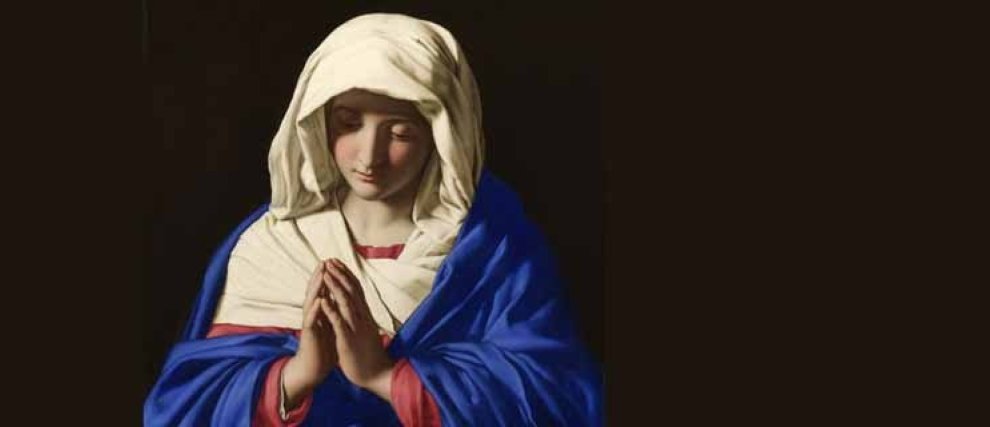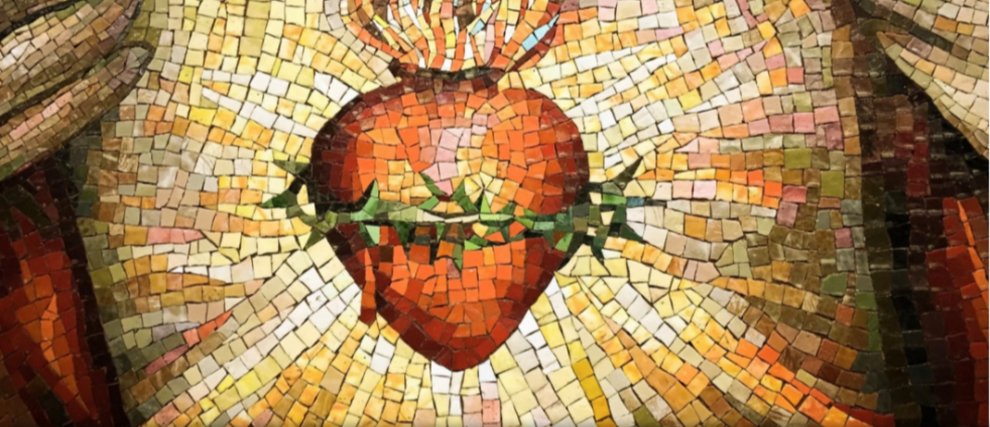Our Lady of Sorrows: Meaning, Celebration, Devotion, Prayers
On September 15, the day after the feast of the Glorious Cross, the Catholic Church invites Christians to celebrate the Virgin Mary under the name of Our Lady of Sorrows or Our Lady of the Seven Sorrows. What is the origin and meaning of this devotion to Mary? What are the seven sorrows of the Virgin? Discover all the meaning of this Marian feast!
Mary, Our Lady of Sorrows, is the one who, through communion with the sufferings of her son, leads us to Jesus. Consecrate yourself now to Jesus through his mother, the Virgin Mary, through :
Why is the title of “Our Lady of Sorrows” attributed to the Blessed Virgin?
What does the name “Our Lady of Sorrows” mean?
The Catholic Church attributes many titles to the Virgin Mary: they are the means for us to enter more deeply into the understanding of the mystery that surrounds her, and to venerate her in many ways.
Thus, on September 15, we celebrate her as Our Lady of Sorrows, or Our Lady of the Seven Sorrows. This title evokes the sorrows endured by the Virgin Mary throughout her earthly life, and more particularly at the time of the Passion of her son, Jesus.
The origins of the devotion to Our Lady of Sorrows
For a very long time, Christians have remembered the sorrows of the Virgin Mary. The consecration of many religious buildings under the names of Our Lady of Sorrows or Our Lady of Compassion testifies to this reality. A chapel dating from the 3rd century was erected under the name of Our Lady of Mercy in Clermont-Ferrand, France.
However, this popular devotion was not formalized until the 13th century: a Marian religious congregation, the Order of the Servants of Mary, instituted the feast of Our Lady of Sorrows on September 15.
Following this, devotion to the sorrows of Mary gradually spread, especially through the Jesuits, who, starting in the seventeenth century, published a series of books devoted to the sorrows of Mary. Among them, for example, is Saint Ignatius of Loyola, who dedicated special worship to the Virgin of Sorrows.
The 7 Sorrows of Mary
The seven sorrows of the Virgin Mary on which we are invited to meditate correspond to events recounted by the apostles in the Gospels:
The prophecy of Simeon about the Child Jesus: “Then Simeon blessed them and said to Mary, his mother: “This child is destined to cause the falling and rising of many in Israel, and to be a sign that will be spoken against, so that the thoughts of many hearts will be revealed. And a sword will pierce your own soul too.” (Luke 2:34-35)
The escape of the Holy Family to Egypt: “When they had gone, an angel of the Lord appeared to Joseph in a dream. “Get up,” he said, “take the child and his mother and escape to Egypt. Stay there until I tell you, for Herod is going to search for the child to kill him.” (Matthew 2:13)
The disappearance of Jesus for three days: “After three days they found him in the temple courts, sitting among the teachers, listening to them and asking them questions. Everyone who heard him was amazed at his understanding and his answers. When his parents saw him, they were astonished. His mother said to him, “Son, why have you treated us like this? Your father and I have been anxiously searching for you.” (Luke 2:41-51)
The Meeting of Jesus and Mary on the Way of the Cross: “A large number of people followed him, including women who mourned and wailed for him.” (Luke 23:27)
Mary at the foot of the Cross: “Near the cross of Jesus stood his mother.” (John 19:25)
Mary, welcoming the body of Jesus when it is taken down from the Cross:“As evening approached, there came a rich man from Arimathea, named Joseph, who had himself become a disciple of Jesus. Going to Pilate, he asked for Jesus’ body, and Pilate ordered that it be given to him.” (Matthew 27:57-58)
Mary, depositing the body of her son at the tomb: “At the place where Jesus was crucified, there was a garden, and in the garden a new tomb, in which no one had ever been laid. Because it was the Jewish day of Preparation and since the tomb was nearby, they laid Jesus there.” (John 19:40-42)
The seven sorrows of the Virgin Mary have been illustrated by many painters: Mary is represented with her heart pierced by seven swords, symbolizing each of her afflictions and making her the queen of martyrs, as she is quoted in the litanies.
The feast of Our Lady of the Sorrows
Why celebrate the Sorrows of Mary on September 15?
On September 15, the Catholic Church invites us to celebrate Our Lady of Sorrows. This feast is inscribed in the liturgical calendar as an obligatory memory of the seven sorrows of the Virgin Mary. While Christians celebrated the feast of the Exaltation of the Cross of Jesus on the previous day, the veneration of the sufferings of Mary is an opportunity to deepen the mysteries of the cross and redemption, with which the Virgin Mary is intimately associated.
This feast is the culmination of a forty-day journey that began with the feast of the Transfiguration of Jesus, and which aims to bring us into the mystery of salvation.
Liturgy of the Memorial of Our Lady of the Sorrows
The liturgy of September 15 leads us to meditate on a passage from the gospel of Saint John: “Near the cross of Jesus stood his mother, his mother’s sister, Mary the wife of Clopas, and Mary Magdalene. When Jesus saw his mother there, and the disciple whom he loved standing nearby, he said to her, “Woman, here is your son,” and to the disciple, “Here is your mother.” From that time on, this disciple took her into his home.” (John 19:25-27)
This passage emphasizes the motherhood of Mary, as the mother of men, but also as the mother of the Church, called to follow the same path of passion and resurrection. We proclaim it during the Mass of the day: “Thou hast willed, Lord, that the Mother of Thy Son, standing by the Cross, should be associated with His Sufferings; grant that Thy Church may also unite herself to the Passion of Christ, in order to have a share in His Resurrection.”
Devotion to Our Lady of Compassion
Our Lady of Sorrows, model of compassion and hope
Meditation on the sorrows of Mary, a mother who suffered silently alongside her son, is a model of compassion for us, especially when we too are in the grip of suffering. Indeed, to contemplate Mary, standing at the foot of her son's cross, in the most total acceptance, is a great consolation in the face of the mystery of suffering.
We also perceive that by uniting herself to the sufferings of her son, Mary shared the glory of her resurrection: “Blessed Virgin Mary! Near the cross of the Lord, without knowing death, she earned the glory of martyrdom.” (Antiphon of the acclamation of the Gospel). For these reasons, Mary is the source of our hope: at the foot of the cross, she became the mother of us all, but also our co-redeemer, that is to say, she participates in a unique way in our salvation!
Saint John Paul II affirms this when he says “At the foot of the Cross, with open arms and a pierced heart, stands our Mother, the Virgin Mary Our Lady of Sorrows and Hope, who welcomes us into her maternal womb filled with grace and compassion. It is a sure path to Christ, our peace, life and resurrection.”
Prayer to Our Lady of Sorrows
“O Mary! O Mother of sorrow, how painful for Your Heart must have been the spectacle of Jesus dying for the ungrateful in the most cruel of torments! But Your Love for us, O Mary, still prevails over the excess of Your pain, and, standing at the foot of the Cross, You consented to the bloody Sacrifice of the beloved Son whose death was to reconcile us with God. Would that I therefore never forget all that your Love for me, only a sinful child, has cost You suffering, anguish on Calvary! For the precious blood that You saw with pain flowing on the Cross, it was my sins that poured it out. So I acknowledge my ingratitude, O Mary! But I also recognize all that You have become to me in this day. Could You ever forget the will of Your dear Son! His last words returned Your adopted children to us: suffer us to call You our Mother. Yes, we took refuge in Your maternal arms, O Holy Virgin! It is through You that we will obtain the grace of a sincere conversion, and under its auspices the great mysteries of the Passion and Death of Our Lord Jesus Christ, with which your Sorrows are inseparable, will be for us the source of a complete renewal in piety and fervor. So be it.”
(Bishop Félix Dupanloup, 1802-1878)
Praying to Our Lady with Hozana!
During her many apparitions—from Pontmain and La Salette in France, to Quito in Ecuador—the Virgin Mary asked for a special devotion to her pains. Join these Hozana prayer communities to respond to her call:
During the Month of Mary, by praying to her daily and drawing inspiration from the saints who loved her.
as we pray this novena in honor of Our Blessed Mother under the title of the Queenship of the Blessed Virgin Mary.
Let us prepare ourselves for consecration to the Immaculate Heart of Mary, to hasten the coming of world peace and the conversion of sinners

